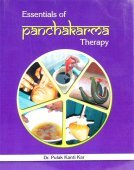Asthapana, Āsthāpana: 7 definitions
Introduction:
Asthapana means something in Hinduism, Sanskrit. If you want to know the exact meaning, history, etymology or English translation of this term then check out the descriptions on this page. Add your comment or reference to a book if you want to contribute to this summary article.
In Hinduism
Ayurveda (science of life)
Source: Wisdom Library: Āyurveda and botanyĀsthāpana (आस्थापन, “non-unctuous enema”):—One of the five pañcakarma (or ‘five measures’) which are employed for Śodhana, an Ayurvedic method for purification of the body by eliminating malas. More specifically, it refers to any non-oily enema (an injection of liquid to motivate evacuation). The literal translation of Āsthāpana corresponds to “causing to stay or remain” or “placing, fixing”. It is composed of the prefix Ā and sthāpana (“maintaining, causing to stand”).

Āyurveda (आयुर्वेद, ayurveda) is a branch of Indian science dealing with medicine, herbalism, taxology, anatomy, surgery, alchemy and related topics. Traditional practice of Āyurveda in ancient India dates back to at least the first millenium BC. Literature is commonly written in Sanskrit using various poetic metres.
Languages of India and abroad
Sanskrit dictionary
Source: DDSA: The practical Sanskrit-English dictionaryĀsthāpana (आस्थापन).—
1) Placing, fixing, causing to stay or remain.
2) A strengthening remedy.
3) An enema of oil or ghee.
Derivable forms: āsthāpanam (आस्थापनम्).
Source: Cologne Digital Sanskrit Dictionaries: Shabda-Sagara Sanskrit-English DictionaryĀsthāpana (आस्थापन).—n.
(-naṃ) 1. Placing, fixing, causing to stay or remain. 2. An enema of oil, ghee, &c. E. āṅ before sthā to stay, causal form. lyuṭ aff.
Source: Cologne Digital Sanskrit Dictionaries: Monier-Williams Sanskrit-English Dictionary1) Āsthāpana (आस्थापन):—[=ā-sthāpana] [from ā-sthā] n. placing, fixing, causing to stay or remain
2) [v.s. ...] a strengthening remedy
3) [v.s. ...] an enema of oil, ghee, etc., [Suśruta]
Source: Cologne Digital Sanskrit Dictionaries: Yates Sanskrit-English DictionaryĀsthāpana (आस्थापन):—[ā-sthāpana] (naṃ) 1. n. Placing.
[Sanskrit to German]
Sanskrit, also spelled संस्कृतम् (saṃskṛtam), is an ancient language of India commonly seen as the grandmother of the Indo-European language family (even English!). Closely allied with Prakrit and Pali, Sanskrit is more exhaustive in both grammar and terms and has the most extensive collection of literature in the world, greatly surpassing its sister-languages Greek and Latin.
See also (Relevant definitions)
Starts with: Asthapanadravya, Asthapanopaga.
Ends with (+57): Anumanapramanyavyavasthapana, Anupasthapana, Arcasthapana, Archasthapana, Aucityasthapana, Avasthapana, Balalingasthapana, Balasthapana, Candeshasthapana, Candrashekharasthapana, Cittasthapana, Devasthapana, Devatasthapana, Dhanyasthapana, Ghatasthapana, Ghatikasthapana, Gopurasthapana, Grahasthapana, Guhasthapana, Hiranyasthapana.
Full-text: Pancakarma, Pratishtha, Asthapanopaga, Dhanyamla, Anuvasana, Sthapana.
Relevant text
Search found 10 books and stories containing Asthapana, Āsthāpana, A-sthapana, Ā-sthāpana; (plurals include: Asthapanas, Āsthāpanas, sthapanas, sthāpanas). You can also click to the full overview containing English textual excerpts. Below are direct links for the most relevant articles:
Puranic encyclopaedia (by Vettam Mani)
Atharvaveda and Charaka Samhita (by Laxmi Maji)
Vāta (Vāyu), Pitta and Kapha (Śleṣma) < [Chapter 4 - Diseases and Remedial measures (described in Caraka-saṃhitā)]
Fever according to Caraka—Synopsis < [Chapter 4 - Diseases and Remedial measures (described in Caraka-saṃhitā)]
5b. Kṛmi (Worms) in the Atharvaveda < [Chapter 5 - Diseases and Remedies in Atharvaveda and Caraka-Saṃhitā]
Sushruta Samhita, volume 4: Cikitsasthana (by Kaviraj Kunja Lal Bhishagratna)
Chapter XXXV - Description of a Netra and a Vasti (pipes, nozzles and apparatus)
Chapter XXXVIII - The treatment with a Nirudha-vasti
Chapter XXXIV - The injudicious use of emetics and purgatives
Philosophy of Charaka-samhita (by Asokan. G)
Action (karma) [in Charaka philosophy] < [Chapter 2 - Fundamental Categories]
Sushruta Samhita, volume 2: Nidanasthana (by Kaviraj Kunja Lal Bhishagratna)
Sushruta Samhita, Volume 6: Uttara-tantra (by Kaviraj Kunja Lal Bhishagratna)
Chapter XXVI - Treatment of diseases of the head < [Canto I - Shalakya-tantra (ears, eyes, nose, mouth and throat)]
Chapter XLV - Symptoms and Treatment of Hemorrhage (Rakta-pitta) < [Canto III - Kaya-chikitsa-tantra (internal medicine)]
Chapter LVII - Symptoms and Treatment of aversion to food (Arochaka) < [Canto III - Kaya-chikitsa-tantra (internal medicine)]
Related products
